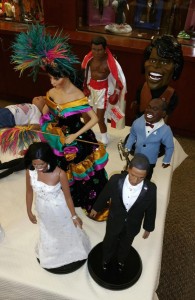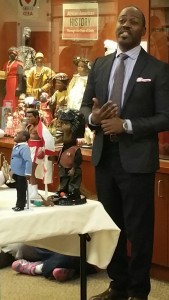For many, they are simply playthings, a ubiquitous element of childhood that is eventually stuffed into a dusty attic or thrown to the curb when their caretakers grow too old for them.
But dolls offer an invaluable snapshot of the past, a physical representation of evolving cultural norms and values that span hundreds of years.
“You can really develop a narrative of African-American history by looking at these dolls,” said Suffolk County Historical Society curator David Byer-Tyre, who organized a sprawling exhibit of African-American dolls in celebration of Black History Month.
The exhibit – located at both the historical society and the Riverhead Free Library – features about 200 African-American dolls from the collection of renowned educator Dr. Judith Kronin. Kronin, who started collecting dolls seriously in 1992, has accrued more than 1,500 dolls – “just about any type of doll that one can think of,” she said.
“I’m interested in dolls because they’re a reflection of society,” she said. “They tell stories.”
 The exhibit is split between two locations: the Riverhead Free Library and the Suffolk County Historical Society. The library features more contemporary dolls, from the mid 20th century onward, while the historical society’s exhibit displays antique African-American dolls, some of which were crafted as long ago as the 17th century.
The exhibit is split between two locations: the Riverhead Free Library and the Suffolk County Historical Society. The library features more contemporary dolls, from the mid 20th century onward, while the historical society’s exhibit displays antique African-American dolls, some of which were crafted as long ago as the 17th century.
By having the exhibit in two locations, they can better tailor the selection to different audiences, Byer-Tyre said.
“The library has more foot traffic, because people go there to do something other than see the exhibit,” he said. “You get a lot more kids who are interested in dolls they’re familiar with – barbies, cartoon characters, action figures.
“At the historical society, you have a captive audience,” he said. “They’re coming because they’re interested in the dolls.”
But for both audiences, he believes people will easily relate to the glimpses of childhood on display and the stories they offer.
“Dolls are part of the natural progression of becoming an adult,” Byer-Tyre said. “They can connect the experiences of both kids and parents. And even though they seem to be socially neutral, they play a huge role in shaping our behaviors.”
He pointed out the ongoing controversy over Barbie’s shrinking waistline. “That can give kids an unrealistic expectation for what body proportions are supposed to look like,” he said.
African-American dolls in particular reveal changing attitudes toward black people throughout the decades. The exhibit’s collection of G.I. Joe dolls, for example, show how the black G.I. Joe – first introduced in 1965 – “climbed the ranks” over the years, Byer-Tyre said.
“Contemporary dolls tend not to have the same negative physical representations of African-Americans as some of the earlier dolls,” he said.
The exhibit also encourages discussion about all the areas in which there is a lack of representation for African-Americans.
“Until a couple years ago, we wouldn’t have been able to have a black president doll,” he said. “You look at the Williams sisters dolls, and you realize that they’re really the only example of black people in tennis.
“You ask the question – why aren’t there certain dolls represented?”
Black dolls were hard to come across for many years, according to Kronin. One American doll designer, Karen Germany, began producing black dolls in 1990 “because she noticed that there were very few black dolls on the market,” Kronin said. “But she retired suddenly in 2000. So now we’re very appreciative of the dolls we bought when they were out,” she said.
“Even the contemporary dolls show a lack of presence of African Americans in certain areas,” Byer-Tyre said. “It allows a conversation that’s not just driven by race, but by the inclusion and exclusion of African Americans in broader society.
“It shows there’s still room for inclusion,” he said. “It shows that we have a ways to go for a fuller representation of African Americans.”
The exhibit will be on display at the Suffolk County Historical Society and at the Riverhead Free Library’s main display case until March 7.
The survival of local journalism depends on your support.
We are a small family-owned operation. You rely on us to stay informed, and we depend on you to make our work possible. Just a few dollars can help us continue to bring this important service to our community.
Support RiverheadLOCAL today.






























